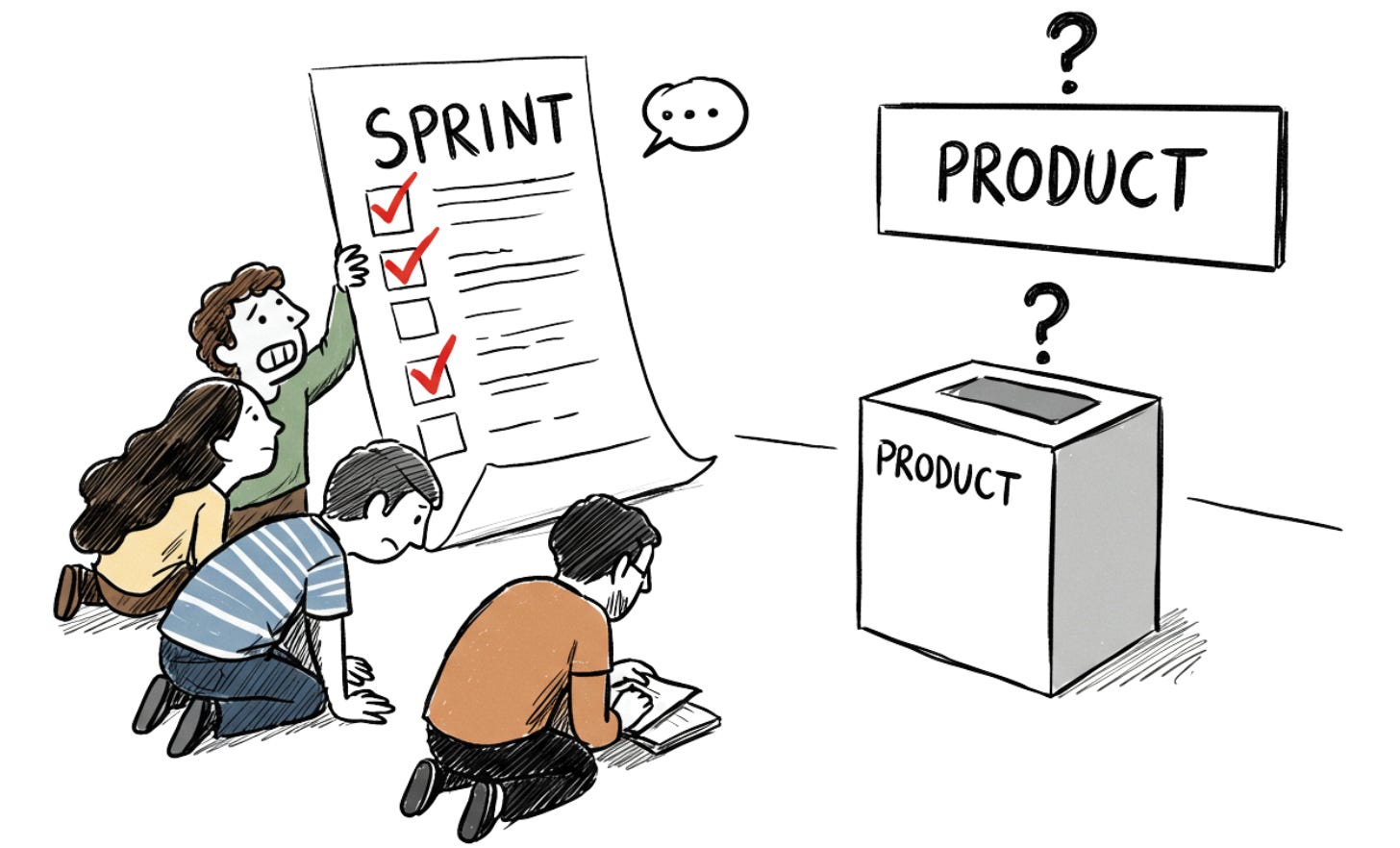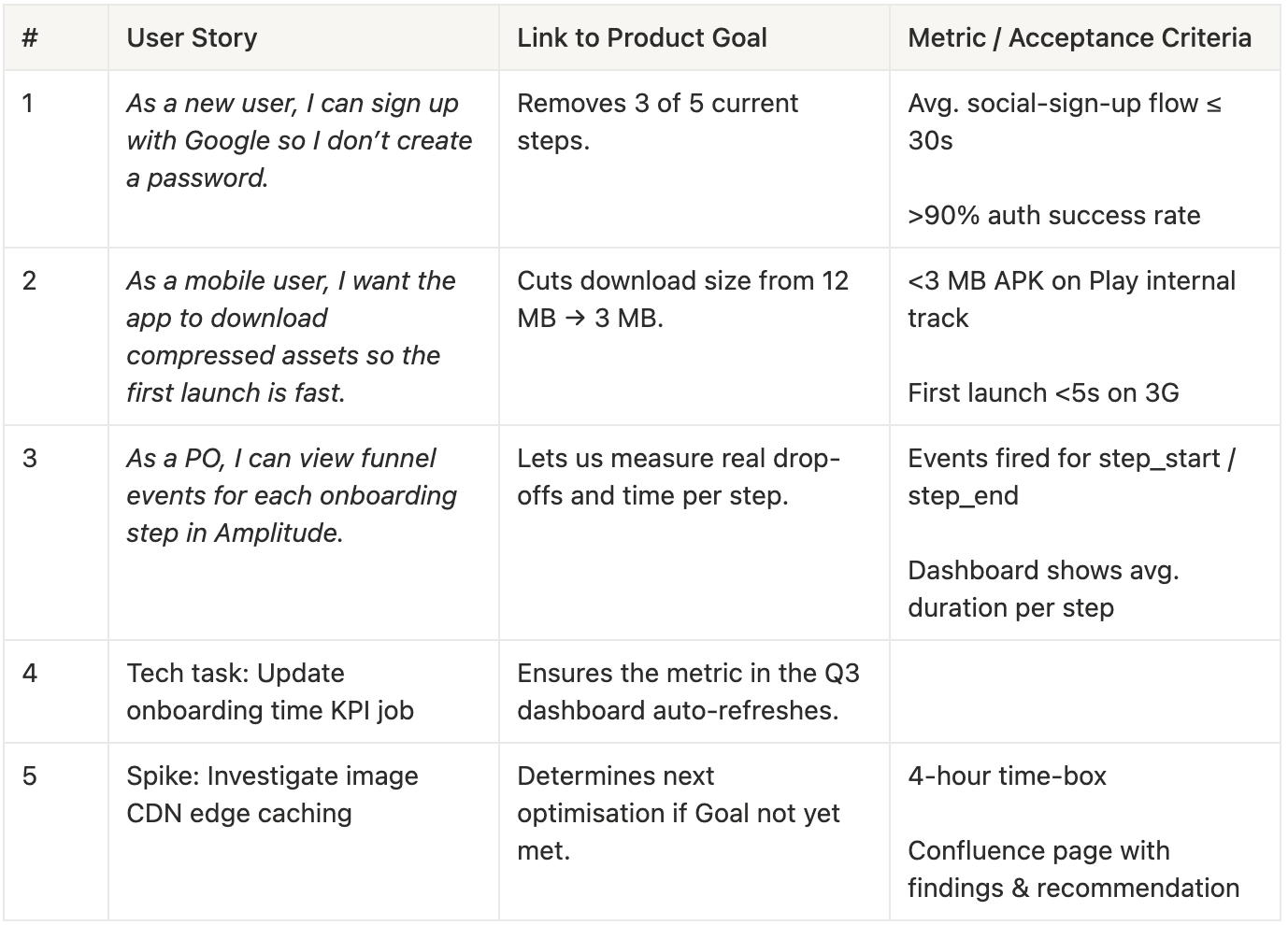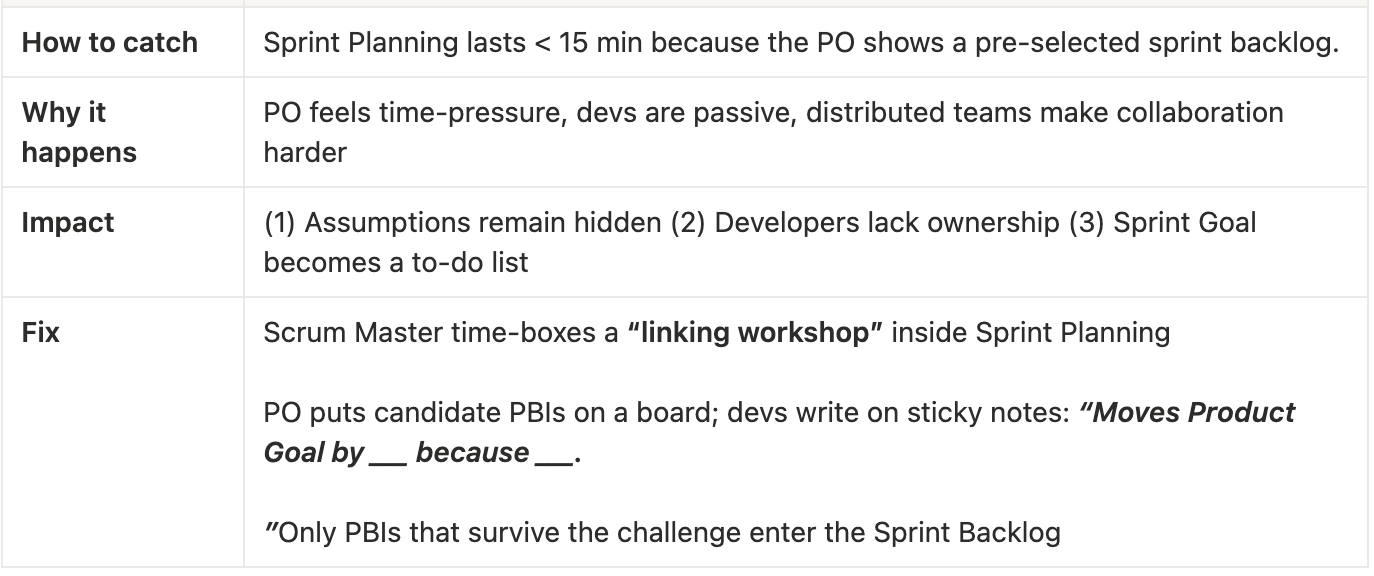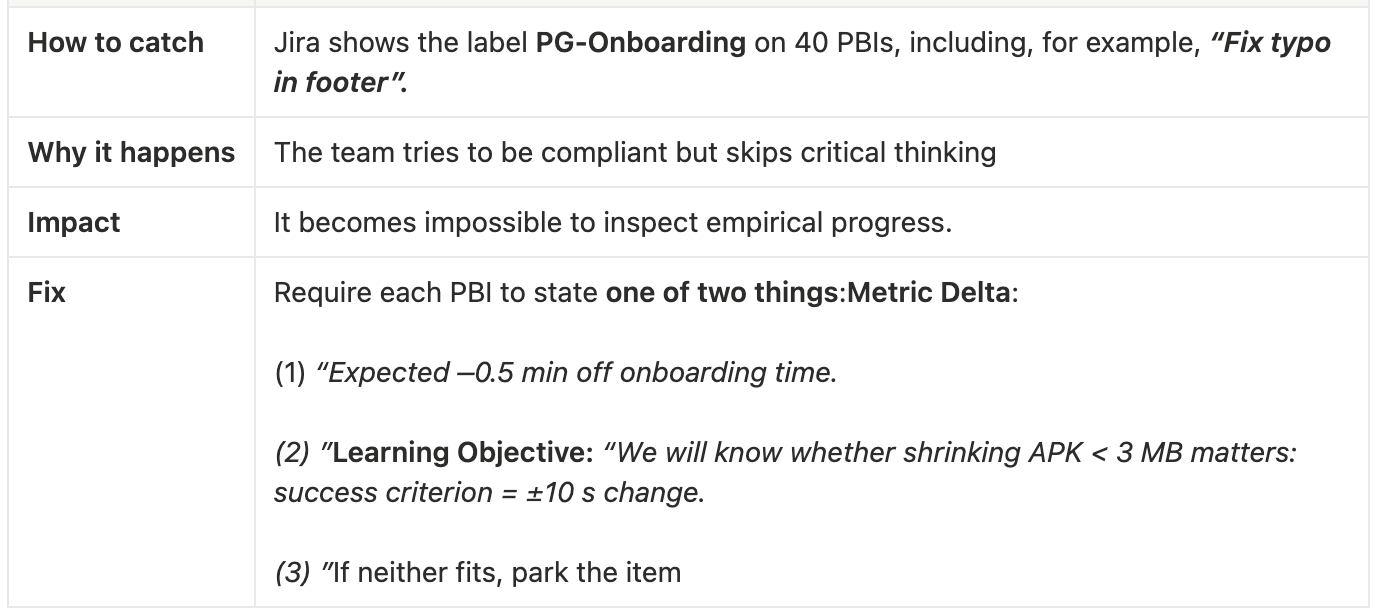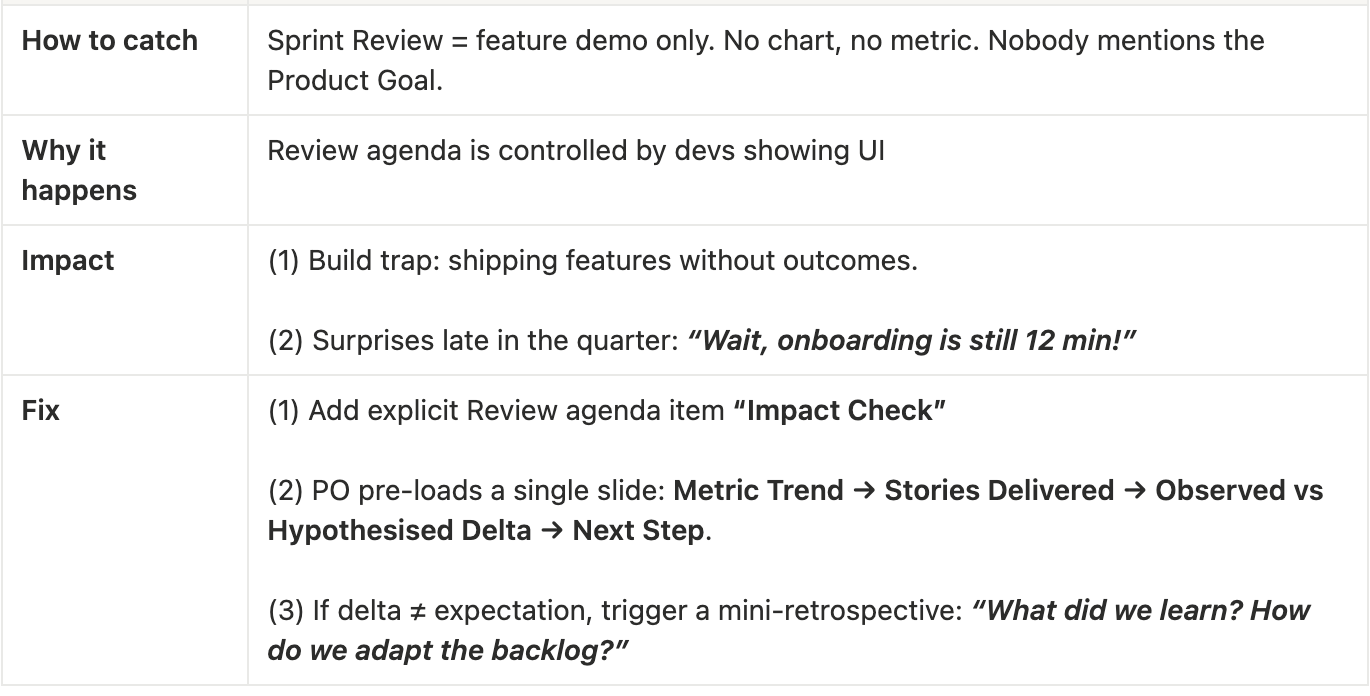Linking Every User Story to the Product Goal
A small habit that keeps the whole Scrum Team laser-focused on outcomes, not output.
When I first started out in this whole “Product” making journey, I really believed that if the team just kept up with filling the backlog and finishing the sprints, we were on the right track.
How wrong I was! It’s amazing how much we learn as we go.
This thinking led to Outputs… 100s of them.
Outcomes?
Outcomes were almost always missing.
Over time, we (my teams and I) grew in our maturity related to Product Thinking and developed numerous ways and habits to focus “more” on Outcomes.
“Linking every user story back to the Product Goal”?
… is one such habit.
In today’s post, I’ll break down this “team habit”, what to watch for, and how this habit can transform your team’s results.
Let’s get started.
Got an urgent question?
Get a quick answer by joining the subscriber chat below.
Why does the “linking” matter?
There are many benefits of linking user stories to the Product Goal.
Below are the four main benefits:
1. Improves Stakeholder understanding
Stakeholders usually struggle to connect Sprint metrics to Strategic promises. “Great, you closed 30 points… so what?”
When the Sprint Review shows a clear link: “Story → Metric → Product Goal Progress,” stakeholders gain a narrative of momentum.
The narrative that they can retell upstairs.
Also, as a plus point…
Leaders micromanage less when they UNDERSTAND the plan.
2. Results in a good Sprint Goal
Many teams leave Sprint Planning with a shopping list: “We’ll do pagination, refactor the logger, and update copy.” Writing a coherent Sprint Goal afterwards feels impossible.
But…
If the backlog is pre-filtered by Product Goal, you naturally pull a thematically related slice. The Sprint Goal often pops out verbatim.
For example,
“Sprint 19 will increase first-session activation (Product Goal) by shipping social sign-up and referral codes. (Sprint Goal)”
Here’s a handy formula:
Sprint X will [Product Goal] by [Sprint Goal]
3. Improves decision making
Prioritization discussions often default to subjective arguments (“I feel search is more important than notifications”) or comparisons of effort (“It’s only two points, let’s just do it”).
Linking user stories to the Product Goal focus discussions to impact: “Which story moves the needle on the Product Goal?”
You can apply simple measures like: (1) Cost of Delay, (2) OKR contribution, (3) impact vs. effort using the Product Goal as the common yardstick.
4. Keeps the Sprint focused on Outcomes, not Output
This post covers this benefit.
By forcing each story to answer, “How will the world be better for our users or business once this is shipped?” you elevate the conversation from “things to do” to outcomes.
The Product Owner is compelled to add context, e.g. “We’re adding CAPTCHA because bots inflate sign-ups and pollute our activation metric.”
In Short…
Linking is a connection between business strategy and code.
What “linking” user stories to the Product Goal looks like
You should be able to finish the sentence:
“Delivering User Story X moves us this much closer to Product Goal Y because ______.”
If the PO or the team is unable to answer this, then the story is either malformed, too large, or irrelevant at this time.
Here’s how to do it.
PO states the Product Goal. Display it prominently. Remind the team of its target metric/OKR
Team briefly revisits progress. PO shows today’s metric vs. target. “We’re 40% of the way; the biggest gap is X.”
PO and Team select candidate PBIs. Pull only items that could affect that metric
For each PBI, ask 3 questions:
How does it move the metric?
What is the smallest slice that still does so?
What assumptions will we validate?
The answer is the link. Capture the link. Add a one-liner in the user story description: Supports PG-2024-Q3: Reduce onboarding time to ≤ 5 min
Tag the item in Jira
After all the selected user stories have a link, write the Sprint Goal that summarizes the common thread
Don’t close the laptop until every PBI in the Sprint Backlog has that explicit “Product Goal” field filled.
Example: From Product Goal to Sprint Goal
Let’s use an example Product Goal below.
Product Goal: “Reduce new-user onboarding time from 15 min to 5 min.”
In 3 simple steps, we can derive the Sprint Goal as follows:
Step 1. Pull candidate stories and link each one to the Product Goal
Note the order: we have not yet written a Sprint Goal. We’re just attaching every story to the Product Goal and writing the specific contribution it could make.
Step 2. Inspect the links and discover the common thread
Common denominator we see after the linking exercise:
All 5 PBIs are aimed at speeding up the onboarding journey and validating that speed.
Step 3. Now write the Sprint Goal (one sentence)
“Shorten onboarding by ≈ 2 minutes through faster sign-up, lighter download, and new funnel analytics.”
Sprint Goal emerges naturally; you don’t have to invent it.
Problem: What happens when a stakeholder interrupts mid Sprint?
Stakeholder: “Can we squeeze in a dark mode?”
Checklist for PO:
Does it reduce onboarding time? No!
Does it enable the above PBIs? No!
Decision by PO:
PO adds it to the Product Backlog, ordered below the current Product Goal items
Message to stakeholder: “Important but out of scope until the onboarding goal (current Product Goal) is met or re-negotiated.”
Of course, the PO may decide to accommodate the stakeholder’s request depending on the nature or severity of the request.
Common Mistakes
Below are some common smells, their impacts, and concrete counter-measures.
1. The PO does it in isolation
2. Rubber stamping every story to the same goal
Product-Goal Link:
• Type: ☐ Metric ☐ Learning
• Target Metric / Question:
• Expected Delta or Discovery:3. Forgetting to check the link
Sprint Review checklist:
(1) Show latest metric (goal, current, delta).
(2) Map each delivered PBI to that delta.
(3) Decide: continue, pivot, or drop the Product Goal.Bottom line
Product Goals are meant to focus, not decorate, the backlog.
If you want your team to adopt the “link every user story to the Product Goal” habit, keep the following 4 guardrails in sight at all times:
Link stories together, never alone. Let the whole team verify the link between each PBI and the Product Goal before it enters the Sprint Backlog
Demand a metric delta (change in metric) or a learning objective for every PBI. If you can’t say what will change or what you’ll learn, the item IS NOT ready
Keep one Product Goal active at a time. Treat it like WIP-limit = 1. Finish, pivot, or abandon before starting a new one
Make the Impact Check non-negotiable in every Sprint Review. Show the metric movement, map delivered PBIs to that movement, and decide next steps
Run your sprints inside these lines, and the linkage practice stops being an overhead. It starts being the engine that steers your product toward OUTCOMES that matter.
Show your support
Every post on Winning Strategy takes ~ 3 days of research and 1 full day of writing. You can show your support with small gestures.
Liked this post? Make sure to 💙 click the like button.
Feedback or addition? Make sure to 💬 comment.
Know someone who would find this helpful? Make sure to recommend it.
I strongly recommend that you download and use the Substack app. This will allow you to access our community chat, where you can get your questions answered and your doubts cleared promptly.
Further Reading
Connect With Me
Winning Strategy provides insights from my experiences at Twitter, Amazon, and my current role as an Executive Product Coach at one of North America’s largest banks.


